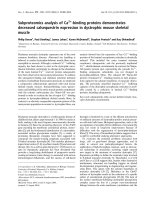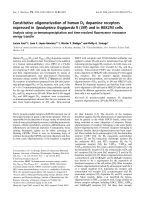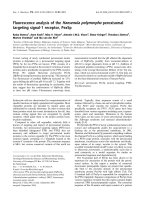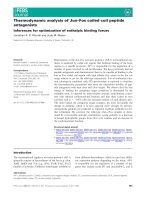Báo cáo khoa học: " Phylogenetic analysis of three genes of Penguinpox virus corresponding to Vaccinia virus G8R (VLTF-1), A3L (P4b) and H3L reveals that it is most closely related to Turkeypox virus, Ostrichpox virus and Pigeonpox virus" ppt
Bạn đang xem bản rút gọn của tài liệu. Xem và tải ngay bản đầy đủ của tài liệu tại đây (585.54 KB, 5 trang )
BioMed Central
Page 1 of 5
(page number not for citation purposes)
Virology Journal
Open Access
Short report
Phylogenetic analysis of three genes of Penguinpox virus
corresponding to Vaccinia virus G8R (VLTF-1), A3L (P4b) and H3L
reveals that it is most closely related to Turkeypox virus,
Ostrichpox virus and Pigeonpox virus
Olivia Carulei
1
, Nicola Douglass
1
and Anna-Lise Williamson*
1,2
Address:
1
Institute of Infectious Disease and Molecular Medicine and Department of Clinical Laboratory Sciences, Faculty of Health Sciences,
University of Cape Town, Cape Town 7925, South Africa and
2
National Health Laboratory Service, Groote Schuur Hospital, Observatory, Cape
Town 7925, South Africa
Email: Olivia Carulei - ; Nicola Douglass - ; Anna-Lise Williamson* - Anna-
* Corresponding author
Abstract
Phylogenetic analysis of three genes of Penguinpox virus, a novel Avipoxvirus isolated from African
penguins, reveals its relationship to other poxviruses. The genes corresponding to Vaccinia virus
G8R (VLTF-1), A3L (P4b) and H3L were sequenced and phylogenetic trees (Neighbour-Joining and
UPGMA) constructed from MUSCLE nucleotide and amino acid alignments of the equivalent
sequences from several different poxviruses. Based on this analysis, PEPV was confirmed to belong
to the genus Avipoxvirus, specifically, clade A, subclade A2 and to be most closely related to
Turkeypox virus (TKPV), Ostrichpox virus (OSPV)and Pigeonpox virus (PGPV).
Background
Interest in the avipoxviruses, notably Fowlpox virus
(FWPV) and Canarypox virus (CNPV) has increased due to
their successful use as vaccines on commercial flocks and
their extensive use and testing as vaccine vectors [1-8]. The
genomes of both FWPV and CNPV have been sequenced
and comparison reveals a high level of divergence with
significant differences between orthologous ORFs and the
terminal, variable genomic regions [9,10]. Analysis of the
thymidine kinase gene showed only 64% amino acid
identity between FWPV and CNPV compared to 97%
amino acid identity amongst the orthopoxviruses and
84% within the Leporipoxvirus genus [11]. This level of
divergence is commonly seen between different Chor-
dopoxvirus genera suggesting that the species within the
Avipoxvirus genus are highly divergent. A novel avipoxvi-
rus, Penguinpox virus (PEPV) was isolated from an Afri-
can penguin (Spheniscus demersus) that was brought into
the Southern African Foundation for the Conservation of
Coastal Birds (SANCCOB) [12]. Lesions around the eyes,
typical of avipoxvirus infection were noted and scrapings
were taken. Virus was cultured from these scrapings and
histological studies and restriction enzyme profile com-
parison to other known avipoxviruses, namely FWPV,
CNPV, Turkeypox virus (TKPV) and Quailpox virus, con-
firmed that it was indeed a novel avipoxvirus [12]. Infec-
tivity studies of different mammalian cell lines (CV-1,
Vero, MDBK, RK-13, HeLa and HEF) and chick embryo
fibroblasts (CEFs) showed that early stages of virus repli-
cation were supported, but no infectious progeny virus
could be recovered [13]. It is currently unclear as to why
PEPV cannot be successfully passaged in CEFs as CEFs
Published: 8 May 2009
Virology Journal 2009, 6:52 doi:10.1186/1743-422X-6-52
Received: 3 February 2009
Accepted: 8 May 2009
This article is available from: />© 2009 Carulei et al; licensee BioMed Central Ltd.
This is an Open Access article distributed under the terms of the Creative Commons Attribution License ( />),
which permits unrestricted use, distribution, and reproduction in any medium, provided the original work is properly cited.
Virology Journal 2009, 6:52 />Page 2 of 5
(page number not for citation purposes)
have been shown to support replication of both FWPV
and CNPV viruses. Also reported was the fact that PEPV
transcriptases could recognize the Vaccinia virus (VACV)
derived late promoter P11 linked to the β-galactosidase
reporter gene, resulting in transient gene expression.
Results and discussion
One highly conserved gene, VLTF-1 (VACV G8R; fpv126
locus), was chosen for analysis in order to position PEPV
in the larger chordopoxvirus group. Two additional genes,
which are less highly conserved (P4b (VACV A3L; fpv167
locus) and the virion envelope protein p35 (VACV H3L;
fpv140 locus)) were selected for analysis in order to deter-
mine the relationship of PEPV to other avipoxviruses pre-
viously analysed at these loci [14]. The analysis involved
MUSCLE [15] amino acid and nucleotide alignments and
construction of UPGMA and Neighbour-Joining [16] phy-
logenetic trees based on these alignments.
The VLTF-1 gene encodes a late transcription factor, which
is highly conserved amongst all poxviruses and is the most
conserved protein between FWPV and CNPV with 95%
amino acid identity [10]. The nucleotide and amino acid
sequences of 18 poxviruses representing all eight Chor-
dopoxvirus genera were analysed at this locus. The overall
tree topologies are as previously reported [17] and this
analysis shows PEPV to belong to the Avipoxvirus genus,
grouping with FWPV, in a separate clade from CNPV, with
strong bootstrap support in both UPGMA and N-J trees
(N-J tree shown below in Figure 1). PEPV showed 96%
amino acid identity to FWPV and 92% identity to CNPV.
The nucleotide identity was lower with 92% identity to
FWPV and 84% identity to CNPV. Divergence is therefore
more easily detected in the nucleotide sequences due to
the increased number of changes and nucleotide
sequences were therefore used for analysis of the P4b and
envelope protein, p35 genes.
The P4b gene encodes a 75.2 kDa virion core protein,
which is highly conserved amongst all poxviruses [18]
and this locus has been used previously in phylogenetic
studies of avipoxviruses [14,19-21] to differentiate
between major clades A, B and C as well as minor clades
A1, A2, A3, A4, B1 and B2. Figure 2 shows an N-J tree
based on a MUSCLE nucleotide alignment of partial
sequences (truncated to 450 nt to ensure that all
sequences were of equal length) of P4b orthologues from
37 avipoxvirus isolates from 17 different species of bird.
This tree gives better resolution of the Avipoxvirus genus
and shows PEPV to belong to the FWPV-like group of
viruses (clade A) as opposed to the CNPV-like group of
viruses (clade B) or the Psittacine viruses (clade C) in both
N-J and UPGMA trees. FWPV and CNPV orthologues
showed an average of 75% nucleotide identity to each
other for the various isolates at this locus. PEPV showed
an average of 90% nucleotide identity to the various
FWPV isolates and 74% identity to the various CNPV iso-
lates. PEPV was found to belong to subclade A2 with 98%
similarity to Falconpox virus (FLPV) and Albatrosspox
virus (ABPV), and 100% homology to both the TKPV iso-
lates (TKPV66 and TKPV98), the Ostrichpox virus (OSPV)
isolate and two of the Pigeonpox virus (PGPV) isolates
(PGPVTP2 and PGPVP).
Figure 3 shows an N-J tree based on the MUSCLE nucle-
otide alignment of orthologues of the envelope protein
p35, which is an immunodominant antigen. PEPV was
found to cluster with the TKPV isolates with strong boot-
strap support while the pigeon isolate PGPVP clustered
with the isolates from albatross and falcon in both N-J
and UPGMA trees. PEPV was found to have 99% nucle-
otide identity with both TKPV isolates in subclade A2,
compared to 95% identity with ABPV and FLPV and 94%
with PGPVP.
Taken together these analyses confirm that PEPV belongs
to the genus Avipoxvirus, and go on to show that PEPV
Phylogenetic tree based on alignment of VLTF-1 (VACV G8R; fpv126 locus) amino acid sequencesFigure 1
Phylogenetic tree based on alignment of VLTF-1
(VACV G8R; fpv126 locus) amino acid sequences.
Neighbour-Joining phylogenetic tree constructed from the
MUSCLE alignment of the amino acid sequences of the VLTF-
1 gene (fpv126 locus) from 18 poxviruses. (Bootstrap values
from 1000 replicate samplings are shown).
100
100
100
100
100
77
80
100
100
100
100
Virology Journal 2009, 6:52 />Page 3 of 5
(page number not for citation purposes)
belongs to subclade A2 with the highest degree of similar-
ity to TKPV isolates 98 and 66. Because there was no OSPV
sequence available for the envelope protein p35 we can
only speculate that PEPV and OSPV are highly similar
based on the degree of similarity at the P4b gene. Previous
work has shown that OSPV, TKPV and FWPV are geneti-
cally, antigenically and biologically related. Ostrich chicks
housed in an enclosure that had previously housed pox
infected turkeys became infected with a poxvirus and
immunisation of susceptible chickens with this poxvirus
protected them from FWPV challenge [22]. OSPV isolated
from ostriches in Israel was found to produce productive
infection in turkeys and furthermore, ostrich chicks in
both Israel and South Africa could be protected by immu-
nisation with FWPV vaccine [23,24]. The host range of
TKPV has been reported to include both ostrich and Hum-
boldt penguin (a close relative of the African penguin),
Phylogenetic tree based on alignment of P4b (VACV A3L; fpv167 locus) DNA sequencesFigure 2
Phylogenetic tree based on alignment of P4b (VACV
A3L; fpv167 locus) DNA sequences. Neighbour-Joining
phylogenetic tree constructed from the MUSCLE alignment
of the nucleotide sequences of the P4b gene (fpv167 locus) of
37 Avipoxvirus isolates from 17 species of bird. (Bootstrap
values from 1000 replicate samplings are shown). (ABPV =
Albatrosspox virus; AGPV = Agapornispox virus; CNPV =
Canarypox virus; FLPV = Falconpox virus; FWPV = Fowlpox
virus; GTPV = Great titpox virus; HOPV = Houbara bustard-
pox virus; MCPV = Macawpox virus; OSPV = Ostrichpox
virus; PEPV = Penguinpox virus; PGPV = Pigeonpox virus;
PRPV = Parrotpox virus; SCPV = Stone curlewpox virus;
SLPV = Starlingpox virus; SRPV = Sparrowpox virus; TKPV =
Turkeypox virus).
PEPV
A1
A2
A3
A4
B1
B2
C
100
100
100
100
100
100
92
100
100
100
100
100
100
100
Phylogenetic tree based on alignment of H3L (fpv140 locus) DNA sequencesFigure 3
Phylogenetic tree based on alignment of H3L (fpv140
locus) DNA sequences. Neighbour-Joining phylogenetic
tree constructed from the MUSCLE alignment of the nucle-
otide sequences of the H3L gene (fpv140 locus) from 15 Avi-
poxvirus isolates from 9 species of bird. (Bootstrap values
from 1000 replicate samplings are shown). (ABPV = Alba-
trosspox virus; CNPV = Canarypox virus; FLPV = Falconpox
virus; FWPV = Fowlpox virus; HOPV = Houbara bustardpox
virus; PEPV = Penguinpox virus; PGPV = Pigeonpox virus;
SRP = Sparrowpox virus; TKPV = Turkeypox virus).
A1
A2
A3
B1
100
100
100
100
100
Virology Journal 2009, 6:52 />Page 4 of 5
(page number not for citation purposes)
though this is unconfirmed [25]. Analysis of a PEPV IL-10
like protein (data not shown) shows this protein to be
most closely related to turkey (Meleagris gallopavo) and
chicken (Gallus gallus) IL-10, with 27% amino acid iden-
tity followed by the IL-10 like protein found in CNPV with
26% amino acid identity. The CNPV IL-10-like protein
showed only 20% identity to the proteins from chicken
and turkey. PEPV infection is evident in juvenile African
penguins especially in the summer months when the pen-
guins spend the majority of their time on land (moulting
and/or nesting) and there are large numbers of mosqui-
toes present, which act as mechanical vectors to transmit
virus (personal communication Dr. Nola Parsons, SANC-
COB). Further research is underway to determine whether
outbreaks in different avian species are caused by the same
virus or by different but closely related viral species.
Materials and methods
PEPV was grown on the chorioallantoic membranes of
embryonated hens' eggs as described previously [13] to
produce a viral stock from which DNA was extracted. Viral
DNA was extracted by conventional methods as described
previously [12] with the following modifications to the
lysis buffer: 10% N-lauryl sarcosinate, 50 mM Tris pH7.8,
200 mM β-mercaptoethanol and no SDS. The PEPV
genomic DNA was sequenced using the Roche/454 GS-
FLX system and all bioinformatics analysis was performed
using the CLC Bio Main Workbench.
Accession numbers of all loci used in this study (Table 1).
For further information on sequences used in this analysis
please refer to [14].
Competing interests
The authors declare that they have no competing interests.
Authors' contributions
OC carried out the molecular genetic, sequence alignment
and phylogenetic studies and drafted the manuscript. ND
and ALW participated in the design of the study, analyses
and interpretation of data and revision of the manuscript.
All authors read and approved the final manuscript.
Acknowledgements
This work is based upon research supported by the South African Research
Chairs Initiative of the Department of Science and Technology and National
Research Foundation.
References
1. Anderson RJ, Hannan CM, Gilbert SC, Laidlaw SM, Sheu EG, Korten
S, Sinden R, Butcher GA, Skinner MA, Hill AVS: Enhanced CD8+T
cell immune responses and protection elicited against plas-
modium berghei malaria by prime boost immunization reg-
Table 1: Accession numbers of all loci used in this study
Isolate G8R (VLTF-1) A3L (P4b) H3L
ABPV AM050392 AM071388
AGPV AY530311
BPSV AY386265
CMPV AF438165
CNPVATCC AY318871 AY318871 AY318871
CNPV72401 AY530306
CNPV1445 AM050375 AM071512
CNPVV AM050384
CPXV AF482758
FLPV36202 AY530306
FLPV1381 AM050376 AM071515
FWPVVR250 AY453172
FWPVUS AF198100 AF198100
FWPVHPB AY530302
FWPVFP9 AJ581527 AJ581527
FWPV174 AM050377 AM071393
FWPVD AM050380 AM071395
FWPVN AM050379 AM071394
FWPVM AM050378
GTPV256 AY453175
GTPVA310 AY453173
GTPVA311 AY453174
HOPV1252 AM050381
HOPV1165 AM071513
LSDV AF325528
MCPV AM050382
MCV U60315
MDPV AY689436
MPXV AF380138
MYXV AF170726
ORFV AY386264
OSPV AY530305
PEPV FJ948104 FJ948105 FJ948106
PGPVB7 AY453177
PGPVTP2 AY530303
PGPVP AM050385 AM071389
PGPV950 AM050386
PRPV AM050383
SCPV18298 AY530310
SLPV AM050391
SPPX AY077832
SRPVDD1258 AY530307
SRPV32002 AY530308
SRPVA468 AY453176
SRPV9037 AM050389 AM071511
SRPV23 AM050390 AM071510
SWPV AF410153
TANV EF420156
TKPV13401 AY530304
TKPV66 AM050387 AM071390
TKPV98 AM050388 AM071391
VACV AY243312
VARV X69198
YLDV AJ293568
Publish with BioMed Central and every
scientist can read your work free of charge
"BioMed Central will be the most significant development for
disseminating the results of biomedical research in our lifetime."
Sir Paul Nurse, Cancer Research UK
Your research papers will be:
available free of charge to the entire biomedical community
peer reviewed and published immediately upon acceptance
cited in PubMed and archived on PubMed Central
yours — you keep the copyright
Submit your manuscript here:
/>BioMedcentral
Virology Journal 2009, 6:52 />Page 5 of 5
(page number not for citation purposes)
imens using a novel attenuated fowlpox virus. J Immunol 2004,
172:3094-3100.
2. Dale CJ, De Rose R, Stratov I, Chea S, Monteflori DC, Thompson S,
Ramshaw IA, Coupar BEH, Boyle DB, Law M, Kent SJ: Efficacy of
DNA and Fowlpox virus priming/boosting vaccines for Sim-
ian/human immunodeficiency virus. Virology 2004,
78:13819-13828.
3. El Garch H, Minke JM, Rehder J, Richard S, Edlund Toulemonde C,
Dinic S, Andreoni C, Audonnet JC, Nordgren R, Juillard V: A west
Nile virus (WNV) recombinant canarypox virus vaccine elic-
its WNV-specific neutralizing antibodies and cell-mediated
immune responses in the horse. Vet Immunol Immunopath 2008,
123:230-239.
4. Engelmeyer J, Larsson M, Lee A, Lee M, Cox WI, Steinman RM, Bhard-
waj N: Mature dendritic cells infected with canarypox virus
elicit strong anti-human immunodeficiency virus CD8+ and
CD4+ T-cell responses from chronically infected individuals.
J Virol 2001, 75:2142-2153.
5. Jäger E, Karbach J, Gnatic S, Neumann A, Bender A, Valmori D, Ayy-
oub M, Ritter E, Ritter D, Jäger D, Panicali D, Hoffman E, Pan L, Oett-
gen H, Old LJ, Knuth A: Recombinant vaccinia/fowlpox NY-
ESO-1 vaccines induce both humoral and cellular NY-ESO-
1-specific immune responses in cancer patients. Proc Natl Acad
Sci 2006, 103:14453-14458.
6. Karaca K, Swayne DE, Grosenbaugh D, Bublot M, Robles A, Spack-
man E, Nordgren R: Immunogenicity of fowlpox virus express-
ing the avian influenza virus H5 gene (TROVAC AIV-H5) in
cats. Clin Diagn Lab Immunol 2005, 12:1340-1342.
7. Poulet H, Brunet S, Boularand C, Guiot AL, Leroy V, Minke J, Audon-
net JC, Desmettre P, Tartaglia J: Efficacy of a canarypox virus-
vectored vaccine against feline leukaemia. Vet Rec 2003,
153:141-145.
8. Taylor J, Meignier B, Tartaglia J, Languet B, Guillemin F, Desmettre P,
Paoletti E: Biological and immunogenic properties of a canary-
pox-rabies recombinant, ALVAC-RG (vCP65) in non-avian
species. Vaccine 1995, 13:539-549.
9. Afonso CL, Tulman ER, Lu Z, Zsak L, Kutish GF, Rock DL: The
genome of fowlpox virus. J Virol 2000, 74:3815-3831.
10. Tulman ER, Afonso CL, Lu Z, Zsak L, Kutish GF, Rock DL: The
genome of canarypox virus.
J Virol 2003, 78:353-366.
11. Amano H, Morikawa S, Shimizu H, Shoji I, Kurosawa D, Matsuura Y,
Miyamura T, Ueda Y: Identification of the Canarypox virus thy-
midine kinase gene and insertion of foreign genes. Virology
1999, 256:280-290.
12. Kow D: Characterization of Avipoxviruses for use in recom-
binant vaccines. In PhD thesis University of Cape Town, Depart-
ment of Clinical and Laboratory Sciences; 1992.
13. Stannard L, Marais D, Kow D, Dumbell KR: Evidence for incom-
plete replication of a penguin poxvirus in cells of mammalian
origin. J Gen Virol 1998, 79:1637-1646.
14. Jarmin S, Manvell R, Gough RE, Laidlaw SM, Skinner MA: Avipoxvi-
rus phylogenetics: identification of a PCR length polymor-
phism that discriminates between the two major clades. J
Gen Virol 2006, 87:2191-2201.
15. Edgar RC: MUSCLE: multiple sequence alignment with high
accuracy and high throughput. Nucleic Acids Res 2004,
32:1792-1797.
16. Saitou N, Nei M: The neighbour-joining method: a new
method for reconstructing phylogenetic trees. Mol Biol Evol
1987, 4:406-425.
17. Gubser C, Hue S, Kellam P, Smith GL: Poxvirus genomes: a phyl-
ogenetic analysis. J Gen Virol 2004, 85:105-117.
18. Binns MM, Boursnell MEG, Tomley FM, Campbell J: Analysis of the
Fowlpox virus gene encoding the 4b core polypeptide and
demonstration that it possesses efficient promoter
sequences. J Virol 1989, 170:288-291.
19. Luschow D, Hoffman T, Hafez HM: Differentiation of avian pox-
virus strains on the basis of nucleotide sequences of 4b gene
fragment. Avian Dis 2004, 48:453-462.
20. Tadese T, Reed WM: Use of restriction fragment length poly-
morphism, immunoblotting, and polymerase chain reaction
in the differentiation of avian poxviruses. J Vet Diagn Invest
2003, 15:141-150.
21. Weli SC, Traavik T, Tryland M, Coucheron DH, Nilssen Ø: Analysis
and comparison of the 4b core protein gene of avipoxviruses
from wild birds: evidence for interspecies spatial phyloge-
netic variation. Arch Virol 2004, 149:2035-2046.
22. Shivaprasad HL, Kim TJ, Woolcock PR, Tripathy DN: Genetic and
antigenic characterization of a poxvirus isolate from
ostriches. Avian Dis 2001, 46:429-436.
23. Allwright DM, Burger WP, Geyer A, Wessles J: Avian pox in
ostriches. J S Afr Vet Assoc 1994, 65:23-25.
24. Perelman B, Gur-lavie A, Samberg Y: Pox in ostriches. Avian Path
1998, 17:735-739.
25. Gerlach H: Viruses. In Avian medicine: principles and application.
Abridged edition Edited by: Ritchie BW, Harrison GJ, Harrison LR. Lake
Worth, Florida: Wingers Publishing; 1997:871.









